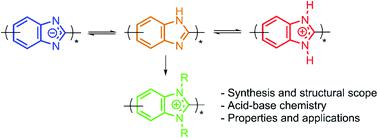当前位置:
X-MOL 学术
›
J. Mater. Chem. A
›
论文详情
Our official English website, www.x-mol.net, welcomes your
feedback! (Note: you will need to create a separate account there.)
From polybenzimidazoles to polybenzimidazoliums and polybenzimidazolides
Journal of Materials Chemistry A ( IF 10.7 ) Pub Date : 2020-06-24 , DOI: 10.1039/d0ta01788d David Aili 1, 2, 3, 4 , Jingshuai Yang 5, 6, 7, 8, 9 , Katja Jankova 1, 2, 3, 4, 10 , Dirk Henkensmeier 11, 12, 13, 14, 15 , Qingfeng Li 1, 2, 3, 4
Journal of Materials Chemistry A ( IF 10.7 ) Pub Date : 2020-06-24 , DOI: 10.1039/d0ta01788d David Aili 1, 2, 3, 4 , Jingshuai Yang 5, 6, 7, 8, 9 , Katja Jankova 1, 2, 3, 4, 10 , Dirk Henkensmeier 11, 12, 13, 14, 15 , Qingfeng Li 1, 2, 3, 4
Affiliation

|
Polybenzimidazoles represent a large family of high-performance polymers containing benzimidazole groups as part of the structural repeat unit. New application areas in electrochemical cells and separation processes have emerged during the last two decades, which has been a major driver for the tremendous development of new polybenzimidazole chemistries and materials in recent years. This comprehensive treatise is devoted to an investigation of the structural scope of polybenzimidazole derivatives, polybenzimidazole modifications and the acid–base behavior of the resulting materials. Advantages and limitations of different synthetic procedures and pathways are analyzed, with focus on homogeneous solution polymerization. The discussion extends to solution properties and the challenges that are faced in connection to molecular weight determination and processing. Methods for polybenzimidazole grafting or crosslinking, in particular by N-coupling, are reviewed and successful polymer blend strategies are identified. The amphoteric nature of benzimidazole groups further enriches the chemistry of polybenzimidazoles, as cationic or anionic ionenes are obtained depending on the pH. In the presence of protic acids, such as phosphoric acid, cationic ionenes in the form of protic polybenzimidazoliums are obtained, which dramatically changes the physicochemical properties of the material. Cationic ionenes are also derived by complete N-alkylation of a polybenzimidazole to the corresponding poly(dialkyl benzimidazolium), which has been intensively explored recently as a new direction in the field of anion exchange membranes. In the higher end of the pH scale in aqueous hydroxide solutions, anionic ionenes in the form of polybenzimidazolides are obtained as a result of deprotonation of the benzimidazole groups. The ionization of the polymer results in dramatically changed physicochemical properties as compared to the pristine material, which is described and discussed. From a technological point of view, performance and stability targets continue to motivate further research and development of new polybenzimidazole chemistries and energy materials. The overall aim of this review is therefore to identify challenges and opportunities in this area from synthetic chemistry and materials science perspectives to serve as a solid basis for further development prospects.
中文翻译:

从聚苯并咪唑到聚苯并咪唑和聚苯并咪唑化物
聚苯并咪唑代表了一大类高性能聚合物,其中含有苯并咪唑基团作为结构重复单元的一部分。在过去的二十年中,电化学电池和分离工艺出现了新的应用领域,这是近年来新的聚苯并咪唑化学和材料的巨大发展的主要动力。这份全面的论文专门研究了聚苯并咪唑衍生物的结构范围,聚苯并咪唑的改性以及所得材料的酸碱行为。分析了不同合成方法和途径的优势和局限性,重点是均相溶液聚合。讨论扩展到溶液性质以及与分子量测定和加工有关的挑战。审查了聚苯并咪唑接枝或交联的方法,尤其是通过N偶联的方法,并确定了成功的聚合物共混策略。苯并咪唑基团的两性性质进一步丰富了聚苯并咪唑的化学性质,因为根据pH值可得到阳离子或阴离子紫罗烯。在质子酸例如磷酸的存在下,获得了质子性聚苯并咪唑鎓形式的阳离子紫罗烯,其显着改变了材料的物理化学性质。阳离子紫罗烯也可以通过完全 进行审查并确定成功的聚合物共混策略。苯并咪唑基团的两性性质进一步丰富了聚苯并咪唑的化学性质,因为根据pH值可得到阳离子或阴离子紫罗烯。在质子酸例如磷酸的存在下,获得了质子性聚苯并咪唑鎓形式的阳离子紫罗烯,其显着改变了材料的物理化学性质。阳离子紫罗烯也可以通过完全 进行审查并确定成功的聚合物共混策略。苯并咪唑基团的两性性质进一步丰富了聚苯并咪唑的化学性质,因为根据pH值可得到阳离子或阴离子紫罗烯。在质子酸例如磷酸的存在下,获得了质子性聚苯并咪唑鎓形式的阳离子紫罗烯,其显着改变了材料的物理化学性质。阳离子紫罗烯也可以通过完全 这极大地改变了材料的物理化学性质。阳离子紫罗烯也可以通过完全 这极大地改变了材料的物理化学性质。阳离子紫罗烯也可以通过完全ñ-将聚苯并咪唑烷基化成相应的聚(二烷基苯并咪唑鎓),近来已作为阴离子交换膜领域的新方向进行了深入研究。在苯甲酸咪唑基团去质子化的结果中,在氢氧化物水溶液的pH值范围的高端,以聚苯并咪唑啉化物的形式获得阴离子紫罗烯。与描述和讨论的原始材料相比,聚合物的电离导致其物理化学性质发生了巨大变化。从技术角度来看,性能和稳定性指标继续激励着新的聚苯并咪唑化学和能源材料的进一步研究与开发。
更新日期:2020-07-07
中文翻译:

从聚苯并咪唑到聚苯并咪唑和聚苯并咪唑化物
聚苯并咪唑代表了一大类高性能聚合物,其中含有苯并咪唑基团作为结构重复单元的一部分。在过去的二十年中,电化学电池和分离工艺出现了新的应用领域,这是近年来新的聚苯并咪唑化学和材料的巨大发展的主要动力。这份全面的论文专门研究了聚苯并咪唑衍生物的结构范围,聚苯并咪唑的改性以及所得材料的酸碱行为。分析了不同合成方法和途径的优势和局限性,重点是均相溶液聚合。讨论扩展到溶液性质以及与分子量测定和加工有关的挑战。审查了聚苯并咪唑接枝或交联的方法,尤其是通过N偶联的方法,并确定了成功的聚合物共混策略。苯并咪唑基团的两性性质进一步丰富了聚苯并咪唑的化学性质,因为根据pH值可得到阳离子或阴离子紫罗烯。在质子酸例如磷酸的存在下,获得了质子性聚苯并咪唑鎓形式的阳离子紫罗烯,其显着改变了材料的物理化学性质。阳离子紫罗烯也可以通过完全 进行审查并确定成功的聚合物共混策略。苯并咪唑基团的两性性质进一步丰富了聚苯并咪唑的化学性质,因为根据pH值可得到阳离子或阴离子紫罗烯。在质子酸例如磷酸的存在下,获得了质子性聚苯并咪唑鎓形式的阳离子紫罗烯,其显着改变了材料的物理化学性质。阳离子紫罗烯也可以通过完全 进行审查并确定成功的聚合物共混策略。苯并咪唑基团的两性性质进一步丰富了聚苯并咪唑的化学性质,因为根据pH值可得到阳离子或阴离子紫罗烯。在质子酸例如磷酸的存在下,获得了质子性聚苯并咪唑鎓形式的阳离子紫罗烯,其显着改变了材料的物理化学性质。阳离子紫罗烯也可以通过完全 这极大地改变了材料的物理化学性质。阳离子紫罗烯也可以通过完全 这极大地改变了材料的物理化学性质。阳离子紫罗烯也可以通过完全ñ-将聚苯并咪唑烷基化成相应的聚(二烷基苯并咪唑鎓),近来已作为阴离子交换膜领域的新方向进行了深入研究。在苯甲酸咪唑基团去质子化的结果中,在氢氧化物水溶液的pH值范围的高端,以聚苯并咪唑啉化物的形式获得阴离子紫罗烯。与描述和讨论的原始材料相比,聚合物的电离导致其物理化学性质发生了巨大变化。从技术角度来看,性能和稳定性指标继续激励着新的聚苯并咪唑化学和能源材料的进一步研究与开发。











































 京公网安备 11010802027423号
京公网安备 11010802027423号